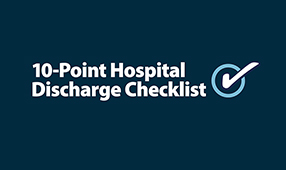Experts say 80-90% of coronary heart disease―the kind that causes heart attacks―is preventable. Although some risk factors such as age and genetic heritage are beyond anyone’s control, others risk factors can be modified. When you make simple changes to lower your risk of heart disease, you’ll be helping to prevent this leading cause of disability and death.
“Heart disease is not a mystery,” says cardiac surgeon Marc Gillinov, M.D., chairman of the Department of Cardiothoracic Surgery at Cleveland Clinic1 and co-author of Heart 411. “We’ve got it figured out. We know what causes it—and how to stop it—and yet, it’s still our number one killer.”
The good news: A few simple switches can help keep your ticker in tip-top shape. First, if you smoke, stop! Second, consider adding these five heart-healthy strategies to your current lifestyle.
1. Eat more produce. A study published in the journal Circulation found that each additional serving of fruits and vegetables enhanced vascular function among people with hypertension. The more fruits and veggies the subjects ate, the greater the response.
There’s another reason to load up on produce: Potassium, a nutrient found in bananas, baked potatoes, raisins, tomatoes and artichokes. A study published in the Archives of Internal Medicine revealed that a diet low in potassium and high in sodium doubles a person’s risk of death from heart disease. In addition to lowering blood pressure, researchers suspect potassium counteracts some of the ill effects of salt, helping prevent the thickening of artery walls.
Another reason to make sure you’re getting enough potassium in your diet: A study published in the Archives of Internal Medicine revealed that a diet low in potassium and high in sodium doubles a person’s risk of death from heart disease.
2. Go fish. Research shows that consuming just one or two servings of fatty fish like salmon, mackerel, lake trout, herring and sardines each week can slash the risk of dying from heart disease by 36%. A bonus: “Fish helps reduce inflammation in the arterial walls and keeps blood flowing to the brain,” explains Ralph Felder, M.D., Ph.D., cardiologist and author of The Bonus Years Diet. In one study, researchers tracked roughly 79,000 women for 14 years and found that those who ate fish at least twice a week had a 51% lower risk of ischemic stroke, usually caused by a blood clot that blocks blood flow to the brain, than those who ate fish less than once a month.
3. Have a daily glass of red. Red wine contains powerful chemicals called polyphenols that reduce cholesterol, prevent blood clots and lower blood pressure. The latest research suggests one polyphenol called resveratrol may also inhibit inflammation. “Resveratrol makes the individual blood cells less sticky and thus thins out the blood, which prevents dangerous blood clots,” says Felder. In fact, studies show that resveratrol improves blood flow to the brain and reduces the risk of stroke. Just don’t go beyond 1-2 drinks a day.
4. Relax. Red wine contains powerful chemicals called polyphenols that reduce cholesterol, prevent blood clots and lower blood pressure. The latest research suggests one polyphenol called resveratrol may also inhibit inflammation. “Resveratrol makes the individual blood cells less sticky and thus thins out the blood, which prevents dangerous blood clots,” says Felder. In fact, studies show that resveratrol improves blood flow to the brain and reduces the risk of stroke. Experts recommend limiting wine consumption to one 4-ounce glass a day for women, two for men.
5. Get moving. Exercise is the single most important thing you can do to stave off heart disease. Don’t worry. You don’t have to become a triathlete. All you need is a pair of shoes and the willingness to move. “Walking for just 30 minutes a day would make a huge difference,” says Gillinov. “And you don’t even have to do it all at once. Break it up throughout the day. It’s the best all-around heart treatment we’ve got.”
According to the American Heart Association’s Walking 101 guide, “even short 10-minute activity sessions can be added up over the week” to reach the goal they recommend: 150 minutes or more of moderate intensity physical activity or 75 minutes of vigorous activity every week. If you want to lower your blood pressure or cholesterol, the AHA suggests aiming for 40 minute sessions of moderate to vigorous activity three to four times a week, such as by walking two miles at a brisk pace (about four miles per hour). If that’s too fast, walk at comfortable pace. You can increase speed and distance as your stamina improves.
Make sure you talk with your doctor before you start a new exercise program, especially if you smoke, have high blood pressure, diabetes, high cholesterol or other cardiovascular risk factors, such as advanced age or a family history of heart disease.
Mark Gillinov MD - Title/
Cleveland Clinic Names A. Marc Gillinov, M.D., Chairman of the Department of Cardiothoracic Surgery, April 14, 2017 News Releases
https://newsroom.clevelandclinic.org/2017/04/14/cleveland-clinic-names-marc-gillinov-m-d-chairman-department-cardiothoracic-surgery/












